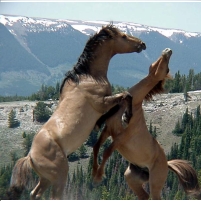Bureau of Land Management Refuses Public Photographing of Wild Horse Roundups
Thursday, January 12, 2012

Photographer Laura Leigh has taken her legal battle to gain access to wild horse roundups by the Bureau of Land Management (BLM) to the Ninth Circuit Court of Appeals. Leigh is a credentialed member of the media representing Horse Back Magazine.
Leigh contends that the BLM’s refusal to allow her to observe and record the gathering of the horses constituted a restriction on freedom of the press. She also sued to stop the agency from using helicopters to chase down the feral animals.
The BLM is holding more than 45,000 captured horses in long-term corrals, while others are killed and sold as meat to foreign countries.
The position of the BLM is that allowing the public close enough to the roundup that they could photograph the event would endanger the onlookers and could possibly scare away the horses before they could be caught.
Leigh lost her case in a lower court and appealed to the Ninth Circuit, where her attorney has argued that the BLM was practicing censorship by keeping his client away from the roundups. “Because the published material is controversial and portrays the government in an unfavorable light, the government’s effective preclusion amounts to content-based censorship,” Gordon Cowan wrote.
A decision is pending from the appellate justices.
-Noel Brinkerhoff, David Wallechinsky
Feds Defend Press Limits to Wild Horse Roundup (by Dave Tartre, Courthouse News Service)
Access Issue Suit Goes to the Ninth (by Laura Leigh, Wild Horse Education)
Wild Horses: Advocate fights BLM, Roundups (by Laura Myers, Las Vegas Review-Journal)
Laura Leigh v. Ken Salazar (Ninth Circuit Court of Appeals) (pdf)
- Top Stories
- Unusual News
- Where is the Money Going?
- Controversies
- U.S. and the World
- Appointments and Resignations
- Latest News
- Trump to Stop Deportations If…
- Trump Denounces World Series
- What If China Invaded the United States?
- Donald Trump Has a Mental Health Problem and It Has a Name
- Trump Goes on Renaming Frenzy






Comments